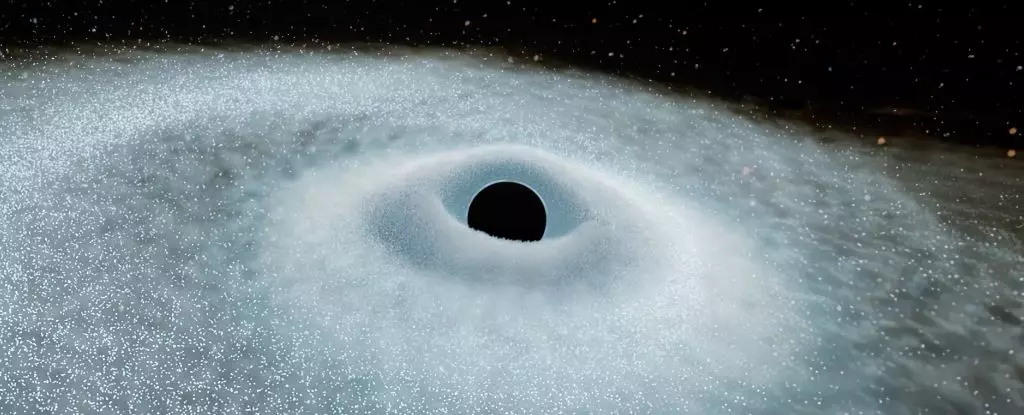In a groundbreaking discovery, the Gaia space telescope has unveiled a mesmerizing phenomenon that deepens our understanding of cosmic explosions: extreme nuclear transients (ENTs). Captured from distant galaxies, these extraordinary eruptions release a staggering energy output that rivals the cumulative brightness of 100 Suns. This captivating find not only enriches our comprehension of celestial events but also sheds light on the enigmatic behavior of supermassive black holes. Astrophysical researchers are just beginning to grasp the implications of these events, which may redefine our knowledge of star destruction and black hole growth.
One cannot help but marvel at the incredible nature of ENTs, especially when juxtaposed with conventional tidal disruption events (TDEs). Scientists have documented the chaos of stars being torn apart by black holes for years, but ENTs reach a dazzling brightness that can be ten times greater than typical TDEs. In essence, these violent cosmic events present a unique opportunity to investigate the fundamental forces governing black hole behavior and the life cycles of massive stars. The fascination lies not only in their intensity but also in their unprecedented longevity, as these brilliant bursts can linger in the cosmos for years.
A Closer Look at Tidal Disruption Events
Generally speaking, a tidal disruption event occurs when a star ventures too close to a supermassive black hole, succumbing to the overwhelming gravitational pull. The stellar remains burst forth in a cacophony of light and destruction, an event that astronomers historically monitored to grasp stellar lifespans and black hole interactions. Until this discovery, these outbursts were thought to have a predictable light curve—brightening rapidly, peaking, and gradually fading over weeks or months.
The term “tidal disruption” belies the sheer violence that an object endures under the force of a black hole. Nevertheless, the definitions and classifications that emerged from traditional TDEs do not encompass the complexity introduced by ENTs. The light curves for these colossal contenders present patterns that differ significantly, providing further insight into the mechanics at play and challenging our established theories.
A Cosmic Treasure trove: Gaia’s Unexpected Discoveries
Originally launched to map our Milky Way, the Gaia space telescope has unexpectedly branched into a new realm of cosmic desktop exploration. While meticulously measuring parallax shifts among stars, Gaia inadvertently observed two pivotal events: Gaia16aaw in 2016 and Gaia18cdj in 2018. Upon further analysis, researchers identified key similarities with a powerful flare recorded by the Zwicky Transient Facility in 2020, which earned the moniker “Scary Barbie.”
These discoveries emphasize the significance of serendipity in scientific progress; while Gaia’s primary mission involved cataloging stars, it revealed the explosive power residing in the distant reaches of the universe. In analyzing these data points, researchers, led by astrophysicist Jason Hinkle, unearthed vital correlations between these ENTs and known TDEs yet proposed an important distinction—the new category of extreme nuclear transients represents an entirely new phenomenon worthy of exploration.
The Implications of Extreme Nuclear Transients
The implications of studying ENTs ripple throughout the field of astrophysics. Researchers estimate that ENTs occur approximately 10 million times less frequently than supernovae. This rarity lends them a unique status as cosmic occurrences worthy of focused study. They offer a valuable lens through which we can learn about the growth patterns of supermassive black holes still shrouded in mystery. Often found at the centers of galaxies, these black holes can be millions to billions of times heavier than the Sun.
Understanding the mechanisms behind ENTs could enhance our comprehension of how these behemoths acquire mass over time. As Benjamin Shappee of the Institute for Astronomy asserts, the luminosity of ENTs allows astronomers to observe them across vast cosmic distances. This attribute presents a remarkable advantage since observing distant phenomena means looking back in time, ultimately expanding our collective understanding of the universe’s evolution.
Further, as we delve into the implications of ENTs, we recognize the potential for these events to unravel secrets concerning the behavior of matter and energy in extreme gravitational fields. Investigations at this scale prompt us to re-examine not only our fundamental laws of physics but also our understanding of stellar evolution, black hole growth, and the cosmic ballet that plays out on grand stages across the universe.
Ultimately, these newly discovered cosmic giants compel us to further explore the depths of our universe, promising to redefine our comprehension of astrophysical phenomena that lie beyond our current horizons. While traditional understandings have prevailed in studying celestial events, the emergence of extreme nuclear transients is a powerful reminder that the universe continues to surprise and challenge our imaginations.

